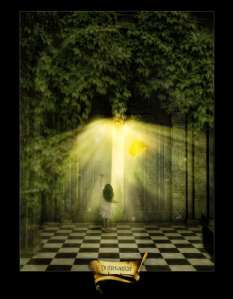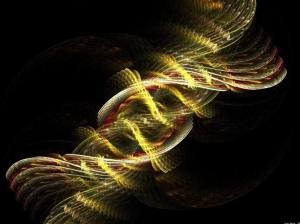Heidekolb's Blog
On Image and Duality – C.G.Jung – The Red Book Reflections | January 11, 2010
In 1925, in the midst of working on the Red Book (RB) Jung wrote “It seemed to me I was living in an insane asylum of my own making. I went about with all these fantastic creatures: centaurs, nymphs, satyrs, gods and goddesses as though they were patients and I was analyzing them”.
 S. Shamdasani, the editor of the RB, noted that Jung found mythological work both exciting and intoxicating. Jung understood mythological images as symbols of the universal life force (libido) depicting the movements and dynamics of the autonomous, archetypal psyche.
S. Shamdasani, the editor of the RB, noted that Jung found mythological work both exciting and intoxicating. Jung understood mythological images as symbols of the universal life force (libido) depicting the movements and dynamics of the autonomous, archetypal psyche.
Jung writes about one of his earlier visions: “On the night when I considered the essence of the God, I became aware of an image.” In this vision he dialogues with Elijah and his daughter Salome. Two thoughts strike me immediately as relevant for an understanding of Jung’s approach. One is his use of the word image.
An image is not to be confused with outer reality. Physicists provide explanations for the nature of matter and outer reality, but one thing is certain, our experience creates an inner image that is not the same as outer reality. The image is a subjective experience in the individual mind. It can be visual, but the experience of a sound or a physical sensation will also bring forth an image. A thought is an image. No question, there is an outer world and also an objective psychic reality, but it is only through the subjective capacity of cultivated self-reflection that one can – with some luck and grace – gain access and insight into the larger, transpersonal realities. An image is like a symbol. It is not to be taken literally or the door becomes a trap holding you prisoner in a concrete and narrow reality. An image is a doorway  into another reality. A paradoxical situation, the image is you and is not you. You are the observer and the observed. A necessary duality has been created. Necessary because all creation depends on this duality and the forever shifting dance between the two opposing forces. A oneness has been torn asunder. It is in the liminal space in-between that new life can be born. In the context of self-reflection the new life can be a new insight, the possibility of a new pattern of experience.
into another reality. A paradoxical situation, the image is you and is not you. You are the observer and the observed. A necessary duality has been created. Necessary because all creation depends on this duality and the forever shifting dance between the two opposing forces. A oneness has been torn asunder. It is in the liminal space in-between that new life can be born. In the context of self-reflection the new life can be a new insight, the possibility of a new pattern of experience.
In the context of a necessary duality, it is interesting that Jung when contemplating the essence of “the God”, encountered a male AND a female figure. The transpersonal may be a field of oneness, but the human intellect can only approximate the divine mystery of creation as two intertwined forces. As above so below. Think DNA. These two opposing forces are often referred to as masculine and feminine, but one must drop all preconceived notions about gender or sexuality. Each individual psyche, male or female, is made up of these energy strands, as is the objective, archetypal psyche. Yang and Yin are more neutral descriptions. Jung elicited the principles of Logos (yang, masculine, foresight, legislation, ordering, willful) and Eros (yin, feminine, receptive, related, moving, dissolving) out of his visionary meeting with Elijah and Salome. Jung writes: The way of life writhes like a serpent from right to left, from thinking to pleasure and from pleasure to thinking. Collectively and individually we are suffering an imbalance in this eternal dance that has favored the masculine principle. Where Logos rules order and persistence prevail, where Logos rules at the expense of Eros, it degenerates into dominance and abuse of power. In the individual this tendency can be associated to the sickness of the soul, known as the narcissistic personality. The problem of narcissism has been thought of as a characteristic of a dying culture. I can see this trajectory, unless psyche is irrigated by the flow of eros and balance is restored one more time again.
These two opposing forces are often referred to as masculine and feminine, but one must drop all preconceived notions about gender or sexuality. Each individual psyche, male or female, is made up of these energy strands, as is the objective, archetypal psyche. Yang and Yin are more neutral descriptions. Jung elicited the principles of Logos (yang, masculine, foresight, legislation, ordering, willful) and Eros (yin, feminine, receptive, related, moving, dissolving) out of his visionary meeting with Elijah and Salome. Jung writes: The way of life writhes like a serpent from right to left, from thinking to pleasure and from pleasure to thinking. Collectively and individually we are suffering an imbalance in this eternal dance that has favored the masculine principle. Where Logos rules order and persistence prevail, where Logos rules at the expense of Eros, it degenerates into dominance and abuse of power. In the individual this tendency can be associated to the sickness of the soul, known as the narcissistic personality. The problem of narcissism has been thought of as a characteristic of a dying culture. I can see this trajectory, unless psyche is irrigated by the flow of eros and balance is restored one more time again.
I am less interested in why Jung’s psyche chose Elijah and Salome as personifications of his unconscious thoughts. These are uniquely his images. It seems of much greater significance how he engaged these images. A method that later became known as Active Imagination. A technique that strongly emphasizes the duality principle. In other words, the ego, the “I” as I know it does not disappear in the face of the visionary figure. One must hold ones ground vis-a-vis an imaginative figure. They are to be met with respect, but not revered as gods, because they are not. Nor are imaginative figures spirits who have all the answers and will tell one what to do. They also don’t foretell the future. Our psychic images are real, but the essence of their reality is behind the surface of the mental image.
It is in this dialogue with Elijah and Salome, in that sacred, liminal space between them that Jung realizes: “If forethinking and pleasure unite in me, a third arises from them, the divine son, who is the supreme meaning, the symbol, the passing over into a new creation. I do not myself become the supreme meaning or the symbol, but the symbol becomes in me such that it has its substance, and I mine.”
Not one, not two. The paradox, nonduality requires duality.
Tags: active imagination, Analytical psychology, C.G. Jung, creation, creative process, creativity, Depth Psychology, divine, duality, eros, god, image, imagination, Jungian psychology, logos, mystery, narcissism, psyche, renewal, soul, The Red Book, transpersonal, yang, yin
7 Comments »
Leave a comment Cancel reply
Archives
Categories
- 2012
active imagination
alchemists
alchemy
Analytical psychology
anima mundi
archetypal feminine
archetype
archetypes
beginnings
blogging
C.G. Jung
collective unconscious
compassion
consciousness
courage
creative process
creativity
darkness
depression
Depth Psychology
dreams
eros
evil
feminine
Freud
god
Greek mythology
Hermes
image
imagination
individuation
Jungian
Jungian psychology
Jungian thought
love
madness
mandala
masculine
mental health
mental illness
movies
mystery
Myth of Ariadne
mythology
narcissism
Nietzsche
North Star
psyche
psychoanalysis
Psychology
psychopaths
psychosis
psychotherapy
religion
renewal
Saturn
society
soul
spirit
Spirituality
symbol
synchronicity
teaching
The Fool
The Red Book
The Tarot
Time
transformation
tree of life
Truth
unconscious
women
word
yin
I am very much enjoying your Red Book reflections.
Comment by Rohaan — January 11, 2010 @ 2:00 am
Quantum Physicists understand that the image of the outer world created in our minds is only a way to visualize a strange world, that does not obey our Aristotelian logic and does not conform to our ideas of space, or time, or causality. You are right even in a deeper sense when you say that our experience creates an inner image that is not the same as outer reality. The external world is revealed to us either by the senses or by extra sensory perceptions. Our senses receive inputs (mainly electromagnetic fields and sound waves) in various frequencies and amplitude; vibrations, nothing more than vibrations. Colors, sounds, textures and forms are created inside our brains; they do not exist outside the observer-observed duality, as you made so clear. And yes, as above so below, even in the sense that our world of everyday life, Maya, receives its meaning and structure from the world of ideas, the world that both Kant and Plato believed the real one. Thank you for your blogs. Daldegan (Conscire)
Comment by Daldegan — January 13, 2010 @ 9:26 pm
For me, this book is a reveal of Jung’s rich archetypal world through paintings and text. A trip into the human subconscious and collective unconscious.
Love it!
Comment by Peter Klein — October 14, 2010 @ 1:10 pm
I really have nothing to say or to add to this marvelous reflection. I just wanted you to know that I have read it and am filled with appreciation.
Comment by Robin Barre — January 22, 2011 @ 2:47 pm
I have enjoyed this comment and chuckled a lot. Cross referencing your comments with Vincent Brome’s :Jung-Man and Myth, I am realising that Elijah is Jung’s cruel caricature of his Father whom he also portrays as Philemon and Salome is both a represantion of Emma,his mother and his sister,Salome. Of course,Jungian purist may object to this.But the mind has it ways of distorting reality!
Comment by Kasozi Musoke — February 12, 2011 @ 12:45 pm
[…] Click here for full article […]
Pingback by On Image and Duality – C.G.Jung – The Red Book Reflections — May 2, 2011 @ 4:11 pm
[…] Click Here for Full article […]
Pingback by Home Improvement — May 26, 2011 @ 6:28 pm